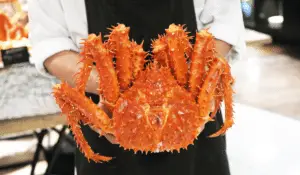Introduction to Imitation Crab: Shelf Life Insights
In the realm of seafood substitutes, a frequent inquiry pertains to the shelf life of imitation crab. This product, made from surimi—a processed fish paste, stands out as a budget-friendly and adaptable option in seafood cuisine. Unlike traditional crab, it brings a distinct taste and texture to the table.
Our aim in this introduction is to shed light on the characteristics of this alternative seafood. We delve into its composition, contrasting it with real crab meat, and discuss its various culinary uses. A key focus is on understanding how long this product remains edible and safe, which is crucial for anyone incorporating it into their meals, influencing both health and flavor profiles.
We will look into aspects such as storage conditions, ingredient quality, and cooking techniques, providing insights into the longevity and freshness of this widely-used seafood imitation. Join us as we explore the important details about the preservation and suitability of imitation crab in your diet
To learn more about the general guidelines for seafood labeling and standards, the FDA’s Consumer Advice on Fish and Shellfish provides useful information.
Storage Guidelines : Ensuring Freshness and Safety
Refrigeration and Freezing Practices
Freshness is a top priority . It should be refrigerated immediately after purchase. If unopened, keep it in its original packaging. For opened packages, place the crab in an airtight container or wrap it well in plastic wrap or aluminum foil. Typically, refrigerated imitation crab remains fresh for two to three days.
Freezing can significantly extend its usability. Wrap the crab securely to prevent freezer burn and use a freezer-safe container or bag for storage. When properly frozen, it can last up to six months. Thaw it in the refrigerator when you’re ready to use it, but avoid refreezing to maintain its quality and safety.
Best Containers and Wrapping Methods
Selecting the right containers and wraps is crucial for avoiding spoilage. For refrigeration, airtight containers are best. They protect against moisture and contaminants, helping the crab stay fresh. If using plastic wrap or aluminum foil, wrap it snugly to prevent any exposure.
For freezing, choose heavy-duty freezer bags or containers specifically designed for this purpose. Expel as much air as possible before sealing to preserve quality and avoid freezer burn. Labeling the container with the storage date is a good practice to track its shelf life.
Adhering to these storage guidelines ensures your imitation crab stays safe and appetizing, ready for your next dish. Proper storage is essential to ensure the longevity of this seafood alternative.”
The US Department of Health & Human Services provides guidelines on FoodKeeper, which includes tips on proper food storage and thawing methods applicable to seafood like imitation crab.
Recognizing Spoilage in Imitation Crab: How to Tell If It’s Not Fresh
Visual Indicators: Spotting Spoiled Imitation Crab
Visual signs are your initial indicators of the freshness of imitation crab. Discoloration is a common sign of spoilage. The Fresh one typically has a consistent pinkish-red and white appearance. Any unusual spots or a shift to dull gray or yellowish hues can indicate it’s no longer good.
Texture Changes: Assessing the Freshness
The texture can also reveal its condition. It should feel firm yet slightly springy. If the texture becomes excessively slimy or mushy, this suggests bacterial growth, often due to improper storage or being kept beyond its best-before date.
Odor: A Crucial Indicator
The smell is a critical aspect in assessing whether imitation crab is fresh. It should have a mild, slightly oceanic scent characteristic of fresh seafood. An off-putting, sour, or unusually strong odor is a definite sign that the crab is spoiled. It’s always safer to discard seafood that smells bad.
In conclusion, visual changes, texture alterations, and an unusual odor are key signs of spoilage in imitation crab. To ensure you’re enjoying fresh and safe seafood, always inspect these aspects. Proper storage is essential to preserve its quality and prolong its edible period.
For recognizing signs of spoilage in seafood products, the USDA’s Food Safety and Inspection Service provides valuable information on food safety
Health Risks of Consuming Spoiled Imitation Crab: Key Concerns
One critical concern is understanding the health implications of consuming it once it’s spoiled.
Food Poisoning Concerns
Eating spoiled imitation crab can lead to food poisoning. When it goes bad, harmful bacteria like Salmonella and Listeria can thrive, posing serious health risks. Symptoms of food poisoning from these bacteria include nausea, vomiting, diarrhea, abdominal pain, and fever. These symptoms can appear within hours of consumption and are especially dangerous for pregnant women, young children, the elderly, and those with weakened immune systems.
To prevent food poisoning, always check for signs of spoilage like an unusual odor, change in color, or slimy texture before consuming imitation crab. Discard any product that seems off, as the risks of consuming spoiled food far outweigh the benefits.
Allergies and Sensitivities
Imitation crab contains fish, often pollock, and additives like wheat and egg whites. People with allergies to fish, shellfish, wheat, or eggs should be cautious, as consuming imitation crab can trigger allergic reactions. These reactions can range from mild symptoms like hives and itching to severe anaphylactic reactions, requiring immediate medical attention.
In conclusion, while imitation crab is a versatile and popular seafood choice, it’s crucial to be aware of its shelf life and potential health risks. Always store it properly and consume it before it goes bad to avoid the risks of food poisoning. Additionally, those with specific food allergies should carefully read labels to ensure safe consumption.
Unleashing Creativity in the Kitchen
Popular Recipes
Wondering about the culinary scope of imitation crab and if “Does imitation crab go bad?” impacts its use in recipes? Absolutely, but when fresh, it’s a versatile ingredient. One popular dish is the classic California roll, where imitation crab adds a seafood flair without the expense of real crab. Another favorite is crab salad sandwiches – mix chopped imitation crab with mayo, a squeeze of lemon, and your choice of herbs for a quick and delightful meal.
Creative Cooking Ideas
Imitation crab shines in a variety of creative dishes. Consider stirring chunks of it into creamy pasta sauces for a seafood-inspired twist. Or, for a heartier option, blend it into crab bisques or chowders, where its flavor melds beautifully with the soup’s richness. For a light appetizer, try making crab-stuffed mushrooms – fill mushroom caps with a mixture of imitation crab, cream cheese, and herbs, then bake until golden.
In summary, imitation crab offers a realm of culinary possibilities, from traditional sushi rolls to innovative soups and appetizers. Its versatility makes it an excellent ingredient for both simple home cooking and more elaborate dishes. Just ensure it’s fresh – remember, if you’re questioning “Does imitation crab go bad?”, it’s crucial to use it at its peak quality for the best flavor and safety.
If you loved this dish, you’ll definitely enjoy the unique flavors in Ultimate Crab Cake Sandwich Recipe: A Coastal Delight. Give it a try!”
Purchasing and Selecting Quality Imitation Crab: Making the Right Choice
Where to Buy and What to Look For
When buying imitation crab, especially if you’re concerned about the question “Does imitation crab go bad?”, it’s essential to know where to shop and what to look for. You can find quality imitation crab at most supermarkets, typically in the seafood or frozen food sections. For the freshest option, choose packages from the refrigerated section. Ensure the packaging is intact, with no tears or excessive moisture, which can indicate poor handling and potential spoilage.
Labels and Ingredients to Be Aware Of
Reading labels is key in selecting the best imitation crab. Look for products with a short list of ingredients, indicating fewer additives and preservatives. High-quality imitation crab primarily contains surimi (fish paste), water, starch, egg whites, and seasoning. Avoid products with a long list of unrecognizable ingredients, as these can detract from the flavor and overall quality.
In summary, when shopping for imitation crab, prioritize freshness and quality. Choose well-packaged products from reputable sources and pay close attention to the ingredient list. Opting for products with fewer additives not only ensures a better taste but also contributes to a healthier choice.
For a richer and more nuanced understanding, continue your exploration with the in-depth analysis provided in the following article Why is Crab So Expensive? An Insight into the Delicacy’s High Cost
Comparing Imitation Crab and Real Crab: Taste, Texture, and Nutrition
The debate between imitation crab and real crab often centers around their differences in taste, texture, and nutrition:
Taste and Texture Differences
Imitation crab, created from surimi (ground fish paste), is designed to mimic the flavor and texture of real crab but with notable differences. While real crab offers a distinct, sweet, and slightly briny flavor, imitation crab has a milder taste, often enhanced with artificial flavors. The texture also sets them apart: real crab is flaky and tender, whereas imitation crab is more uniform and can sometimes be rubbery.
For culinary uses, this means that imitation crab may not always be a suitable substitute for dishes where the delicate flavor of real crab is pivotal. However, it works well in recipes like salads, rolls, or casseroles, where it’s mixed with other ingredients.
Nutritional Comparisons
Nutritionally, real crab and imitation crab diverge significantly. Real crab is a rich source of protein, omega-3 fatty acids, vitamins, and minerals like zinc and selenium. It’s low in calories and fat, making it a healthy choice for many.
In contrast, imitation crab, while still a good protein source, contains added sugars, preservatives, and sometimes monosodium glutamate (MSG) to enhance flavor. It’s also higher in carbohydrates due to the starches used in its production. For those monitoring their sugar or carbohydrate intake, real crab is the healthier option.
To sum up, while imitation crab serves as an affordable and accessible seafood alternative, its taste, texture, and nutritional content are distinct from real crab. And when it comes to shelf life, the query “Does imitation crab go bad?” is relevant, as it doesn’t last as long as real crab, especially when not stored properly. Understanding these differences can guide you in making informed choices based on your dietary needs and culinary preference
For a deeper understanding and more detailed information on this topic, I highly recommend exploring Are Crab Cakes Healthy? Unraveling the Nutritional Facts
The Environmental Impact of Imitation Crab Production: Sustainability and Ethics
Sustainability and Ecological Concerns
Evaluating the environmental implications of producing surimi-based seafood alternatives is essential, especially when considering their ecological footprint. Products like surimi-based seafood, typically used as crab substitutes, often utilize more sustainable fish like pollock. This choice contrasts with the environmental issues associated with overfishing certain species. Nonetheless, the overall sustainability of these seafood alternatives largely depends on the fishing practices for their source fish. Commitment to responsible sourcing and adherence to sustainable fishing guidelines plays a pivotal role in minimizing environmental impact.
Ethical Considerations
Ethical considerations in imitation crab production extend beyond the simple query, “Does imitation crab go bad?”. It involves examining the entire supply chain. This includes the working conditions of those involved in fishing and manufacturing and the additives used in the product. Ethical production means ensuring fair labor practices and avoiding harmful chemicals or excessive preservatives that might impact consumer health and the environment.
In summary, the environmental and ethical aspects of imitation crab production are complex. While it offers a more sustainable alternative to certain overfished species, it’s essential to consider the entire production process. Consumers should look for products adhering to sustainable and ethical practices to ensure their choices support not just their health and taste preferences, but also the well-being of the environment and those involved in its production.
For insights into sustainable seafood practices, Oceana’s Living Blue: Sustainable Seafood Guide provides comprehensive information.
The Monterey Bay Aquarium’s Seafood Watch is an excellent resource for understanding which seafood is sustainable and which to avoid, aiding in environmentally conscious decisions.
FAQs About Imitation Crab: Expert Answers to Common Questions
-
What Exactly is Imitation Crab?
It’s made from surimi, a fish paste usually derived from pollock, and is altered in flavor and color to resemble crab meat. This product finds its place in a variety of dishes.
-
How Long Does Imitation Crab Last in the Fridge?
When stored properly in the refrigerator, preferably in an airtight container, it can remain fresh for about 2-3 days.
-
Can You Freeze Imitation Crab?
Yes, you can freeze imitation crab to extend its shelf life. Wrap it tightly and use it within six months for the best quality.
-
Does Imitation Crab Go Bad If Left Out?
Similar to many seafood products, it should not be left out at room temperature for more than two hours to prevent bacterial growth.
-
How Can You Tell if Imitation Crab Has Gone Bad?
Look out for a sour or ammonia-like smell, a change to a slimy texture, and any discoloration. If you notice these signs, it’s safest to discard it.
-
Is Imitation Crab Healthy?
It’s a low-fat and protein-rich option, though it contains higher carbohydrates and additives compared to real crab. It suits some dietary preferences but may not be ideal for all.
By understanding these important aspects, you can safely enjoy this seafood alternative. Remember, its proper storage and shelf life are crucial to ensure you consume it at its best quality.
Conclusion
As we delve into the shelf life and quality of surimi-based seafood substitutes, we’ve examined various facets of this versatile option. This exploration covers everything from its longevity and proper preservation methods to its culinary applications and impact on the environment. Such products offer both convenience and aspects to consider.
With its distinct production and ingredients, this affordable seafood alternative has a manageable shelf life when stored correctly, either refrigerated or frozen. It’s crucial to use it while it’s fresh and stay alert for any signs of spoilage, like alterations in color, texture, and smell.
In the kitchen, the adaptability of surimi-based substitutes is evident in a range of dishes, from classic sushi to innovative pasta creations. Its ability to emulate real crab’s flavor and texture makes it a favored ingredient globally.
However, it’s equally important to acknowledge the environmental and ethical considerations of its production. Emphasizing sustainability and ethical sourcing is key to reducing environmental impacts. As informed consumers, our mindful choices can significantly support these initiatives.
In conclusion, surimi-based seafood substitutes represent more than just a query about their longevity. They embody a balance we seek in our diets – between convenience and quality, flavor and health, cost-effectiveness and ecological responsibility. By comprehending these nuances, we can value their role in our culinary experiences and make choices that align with our principles and lifestyle




5 thoughts on “Does Imitation Crab Go Bad? Essential Shelf Life Guide”
Comments are closed.